- Screen Colours:
- Normal
- Black & Yellow
Copperas article in the January 2023 Newsletter from Mervyn Russen
I worked for close on forty years for Fisons. A large proportion of my career was spent at Bramford Works – that now very sad, burned-out, brownfield site in Paper Mill Lane.
We took in a lot of Copperas from British Steel there in the 1970s (which is iron(II)sulphate or ferrous sulphate). When we received it, the green-coloured material was very damp and contained some free sulphuric acid. We formulated it into our moss killing products because ferrous ions kill moss.
I must point out that ferrous sulphate is not the same as iron pyrites (see paragraph two of your article). Iron pyrites is a form of Iron sulphide not sulphate. Iron sulphate can be produced from iron sulphide by the action of oxygen in the air and water as you mention in the latter part of your article. The process is accelerated by the presence of Acidithiobacillus bacteria.
The equation for this reaction without using chemical symbols is:

In the distant past, Fisons at Bramford prepared sulphuric acid by roasting iron pyrites which converts it to iron oxide and sulphur dioxide. The sulphur dioxide was then converted to sulphuric acid using a process known as the Lead Chamber process. The acid was subsequently reacted with rock phosphate (or in the old days; coprolites) to produce superphosphate. The latter can be used in fertilizer formulations because the phosphorus is in a more soluble form and is more available to growing plants than it is as rock phosphate or as raw coprolites. The iron oxide remaining after the pyrites had been roasted was very often buried on the site.
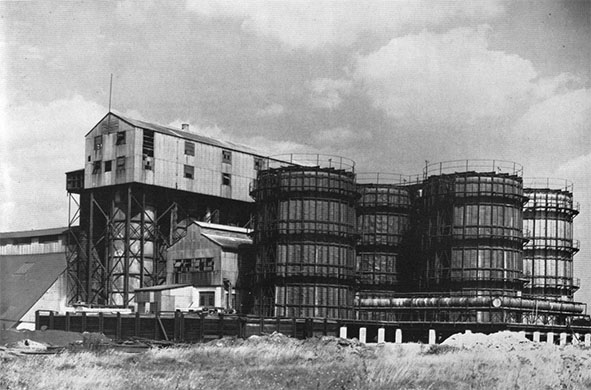 Fisons at Bramford
Fisons at Bramford
Pyrites is dug out of the ground as a source of sulphur but it often contains appreciable amounts of arsenopyrite contaminant – therefore the buried iron oxide from the roasting process was also contaminated with arsenic. Hence Bramford Works has soil in parts of the site quite heavily contaminated with the latter. I understand that a previous prospective developer of the site intended to cover the contaminated land with a concrete cap and build housing on that.
The last Lead Chamber plant in the Ipswich area was situated on the hill above Cliff Quay Works where Fisons Fertilizer Division operated. The acid plant operated there from 1932 until 1964. The acid was again used to produce superphosphate at Cliff Quay several years after Bramford ceased doing it. Please see the picture of the Cliff Quay acid plant (right) taken from a Fisons Journal of 1964.
I should also add that the International Union of Pure and Applied Chemists has deemed now that sulphur and sulphate shall be spelled sulfur and sulfate. This adopts the spelling long used by the Americans. I have used the “ph” spelling to coincide with your article and because I come from the old school of chemists.
ANPR cameras and Big Brother from David Vincent
I have just had a run-in with Napier Parking, who use ANPR cameras on the Wolsey Car Park (the former Civic Centre site). I have been fined £100 for NOT parking there. I simply couldn’t get the automatic ticket machines to accept my debit card for payment. After several attempts I gave up and parked in Elm Street instead. I am appealing against the fine.
I can see the attraction for businesses like Napier Parking. They don’t have to pay staff on site, and if the ANPR camera can catch the driver, the DVLA will give them their home address. Even an early paid fine of £60 is a nice little earner. I have seen stories over the years about local authorities in London earning millions every year in fines from drivers who stray into yellow boxes or drive in bus lanes.
Now ANPR is coming to Ipswich and Suffolk County Council has approved four sites including the middle section of Fore Street, Upper Brook Street and Dog’s Head Street. SCC will install expensive pilot schemes, using ANPR to punish motorists. Each site costs £200,000 to install, plus annual maintenance and the cost of cameras. They make money because they can issue fines 24 hours a day.
Even the trade bodies for the parking industry admit that applications to get car owner details from the DVLA rocketed to nearly six million by 2018.
The reason for the Fore Street project is that Ipswich Buses complain their buses driving into town are delayed by car drivers using it as a short cut. This middle part is one-way north, but businesses still need access to their premises and delivery vans need to get to the retailers, including the Post Office. Buses going into town need to cross Star Lane to head north towards Tower Ramparts. Some bus drivers skip the middle section of Fore Street completely, swing round to the left and then turn into Slade Street to join Star Lane where they get a green light to continue on. I saw it yesterday, a No. 2 bus from Ipswich Hospital.
The problem with Ipswich is that the medieval street pattern isn’t ideal for buses or for the substantial number of cars using the road network today. Where dual carriageways have been created, like Star Lane, drivers can speed along to the next pinch point.
 I don’t think the installation of ANPR cameras will improve anything. The town is congested because there is a lot of traffic – even more delivery vans since lockdown – and it is all going somewhere. Suffolk County Council will need to make £50,000 each year in fines just to pay for the system.
I don’t think the installation of ANPR cameras will improve anything. The town is congested because there is a lot of traffic – even more delivery vans since lockdown – and it is all going somewhere. Suffolk County Council will need to make £50,000 each year in fines just to pay for the system.
The real problem in upper Fore Street is that it narrows towards the Eagle Street/Orwell Place crossroads which is unsuitable for large vehicles to turn. When an in-bound bus meets a delivery vehicle the traffic grinds to a halt.
I see SCC is also going to use ANPR to catch speeding drivers in the Shotley and Felixstowe areas and has plans for mobile units, to be used occasionally at other speeding hotspots. If our highways authority is so flush with money, I would like to see some of the Ipswich streets made safer with better street lighting. Key Street near Fore Street and large parts of the quayside would be safer with better, more efficient lighting on winter nights.
New fruit farm fleece from Pauline Hemingway
Concerning the article in the January issue of the Newsletter about the disfiguration of the Dedham Vale area as a result of the use of white fleece protection for the apple trees, surely the answer is to dye the fleece grass-green. Then it will only be the pylons that spoil the view!
After all, we do not want to jeopardise food production, do we?
The Wolsey Pageant from David Saunders
I expect that I'm not the first to contact you about the Cardinal Wolsey item in the January 2023 Newsletter [Issue 232].
The Wolsey Pageant in front of Christchurch Mansion was held in 1930 and not 1923. I have several postcards (including the one in the Newsletter) taken by the firm of ‘Walters’ who I believe were a local firm of photographers. One or two of these also show the man in the hat who must have been the director/producer. There is no mention of a director in the programme but the list of officials is headed by the producer, Mr Nugent Monck. I assume the photographs were taken during a dress rehearsal so that the postcards would be ready to sell at the performances.
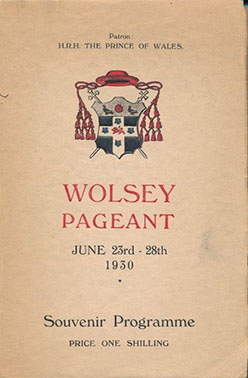
The cover of the programme for the original Wolsey Pageant in Christchurch Park, Ipswich, 1930.
There have been at least two other pageants in Christchurch Park; one in 1931 To Kill the Queen and another in 1951. I attach some photographs that may be of interest.
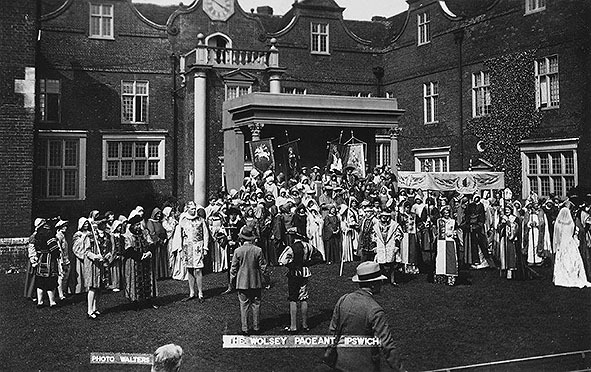 A different view of the Pageant rehearsals from that shown in our January issue; attributed to ‘Walters’.
A different view of the Pageant rehearsals from that shown in our January issue; attributed to ‘Walters’.
(I believe that the firm of Walters was founded by Harry Walters towards the end of the 19th century. He liked to do trick photographs to make them into postcards. One involved the base of Queen Victoria's statue in the park – but that's another story!)
My wife and I always enjoy reading the Newsletter – keep up the good work!
[Thanks for the correction. The Chairman provided the postcard image we used which had the wrong date on it; unfortunately, rather than checking it, I repeated the error in the accompanying caption. –Ed.]
The 1931 Pageant play programme; the 1951 Pageant programme.
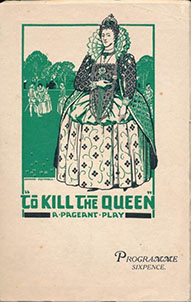
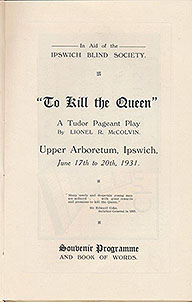
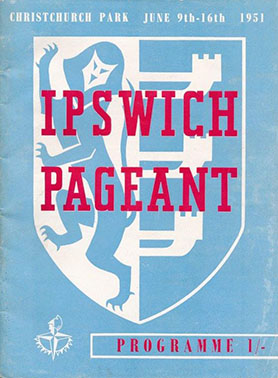
Baylham Mill from Mark Beesley
Just to say how much I enjoyed the latest Newsletter [Issue 232], especially the article about Baylham Mill. When we first moved to Suffolk in 1979 we lived at Needham Market and explored the local area by bike. One of the first places we discovered was Baylham Mill and we revisited often because it was such an atmospheric place: very neglected but the mill house was clearly still inhabited, though I never saw anyone there. The fields around it were all overgrown and the mill itself was dark and full of cobwebs and appeared to still have its machinery intact. It was also home to a lot of feral cats. I didn't know about the Poussin [painting]: fascinating stuff. I seem to recall Mr Onians was a well known local 'character' – there were several in Needham including the Revd Hargrave-Thomas, a retired clergyman who used to wander round the town dressed all in black and offer everyone he met a mint, which he'd produce from his pocket covered in fluff. Sadly, the Great British Eccentric seems to be rapidly dying out, as do the places that go with them, like Baylham Mill. One-by-one they get tidied up and gentrified.
Pickers Hill from Alan Forsdike
I am undertaking a sizeable piece of work transcribing a large pile of deeds left in our house [Hill House] by the previous occupiers – it’s only taken me 27 years to get around to it.
Anyway, my reason for writing is an article in issue 183 (April 2011) of The Ipswich Society Newsletter which I read on-line [The Grand Old Duke of York in Issue 183, April 2011.]
We were looking for references to Pickers Hills in Google and that article comes up. The writer Louis Musgrove refers to Pickers Hill and says ‘wherever that is’ – I can tell you! It was that portion of Christchurch Park which was leased off in 1837 for grazing and then sold in parcels to the builders of the houses in what became Fonnereau Road (then it was Dairy Lane) and 2 & 4 Henley Road (then known as ‘the Turnpike road leading to Hemingstone’).
Amazing what you find on Google*! If Louis is still around, I would like to put him out of his misery.
(Other search engines are available. –Ed.)